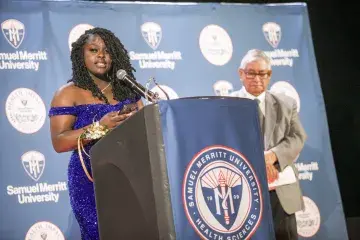Camille Gonzales: Putting OT to Work in Mental Health
Profiles of Passion is a series of stories about SMU students and alumni who are demonstrating their dedication to transforming healthcare in their communities and the world. Click here for other stories in the series.
People who find out that Camille Gonzales works at a psychiatric hospital often ask her whether she feels safe, a reflection of the stigma surrounding mental illness. But the truth is she is not afraid and has never been more excited about going to work.
“I'm reminded every day why I made the decision to accept this position,” says Gonzales, an occupational therapist (OT) at John George Psychiatric Hospital in San Leandro. “The team, the program, and each patient have all already touched me in one way or another.”
Gonzales graduated late last year from Samuel Merritt University’s Occupational Therapy program, where she was exposed to multiple healthcare settings and experienced all sorts of patient populations. When it came to looking for a job, however, she returned to her original passion.
“My heart was set on landing a mental health position,” she says.
At John George, where she began working in early July, Gonzales provides inpatient therapy to acute psychiatric patients — teens to older adults — with diagnoses ranging from depression and bipolar disorder to substance abuse and schizophrenia. She runs wellness groups to promote coping skills, socialization, and the ability to perform activities of daily living such as hygiene and other self-care.
Collaborating with other healthcare providers is the most effective way to treat and stabilize acute psychiatric illness, according to Gonzales. She works on an interdisciplinary team of social workers, mental health specialists, nurses, pharmacists and psychiatrists that shapes the course for each patient. Occupational therapists like Gonzales report patients’ behavior, including how they are responding to treatment, their ability to socialize, and what discharge setting is most appropriate for their cognitive functioning level.
“SMU did a great job about teaching us about the interdisciplinary team,” she says, pointing to an interprofessional communication course she took with physical therapy students and the opportunity to work alongside other healthcare students on hospital scenarios in the University’s Health Sciences Simulation Center.
Gonzales decided to become an OT after working for four years as child development counselor at the San Diego Center for Children, a residential treatment center for children and adolescents with mental illness.
“I absolutely loved my work with the at-risk youth and in mental health, and was considering going into counseling,” she says. But that was before she witnessed how the center’s OT positively influenced the children’s behavior. She says kids who had previously come home from school in a furious flurry, acting out aggressively, would instead skip through the door in the highest of spirits. When she asked them why they were so happy, they said they had seen the OT.
“I realized occupational therapy had the most important component of being client-centered and figuring out what is meaningful for each client and working therapy around that to really precipitate change,” Gonzales says. “I loved the idea of being more hands on, which I am, rather than just relying on verbal therapy.”
While working with psychiatric patients may seem daunting because of the many social stigmas, Gonzales says looking at each person for who they truly are makes OT a fulfilling profession.
“This is the most rewarding work I've done,” says Gonzales.


